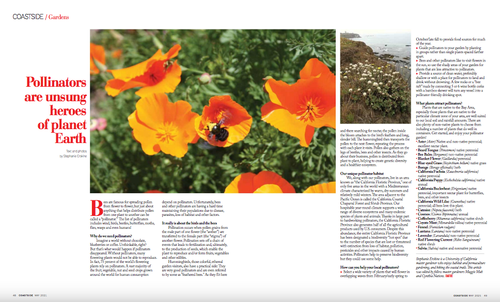What is a Pollinator?
Bees are famous for spreading pollen from flower to flower but just about anything that helps distribute pollen from one plant to another can be called a “pollinator.” The list of pollinators includes wind, birds, beetles, butterflies, moths, flies, wasps and even humans!
Why do we need pollinators?
Imagine a world without chocolate, blueberries, or coffee—unthinkable, right? But that's what would happen if pollinators disappeared. Without pollinators, many flowering plants would not be able to reproduce. In fact, 75% of the world's flowering plants rely on pollinators. A vast majority of the fruit, vegetable, nut and seed crops grown around the world for human consumption depend on pollinators. Unfortunately, bees and other pollinators are having a hard time maintaining their populations due to disease, parasites, loss of habitat and other factors.
What is pollination? It really is about the birds and the bees
Pollination occurs when pollen grains from the male part of one flower (the “anther”) are transferred to the female part (the “stigma”) of another flower. Pollination sets off a chain of events that leads to fertilization and ultimately, to the production of seeds, which enable the plant to reproduce and/or to form fruits, vegetables and other edibles.
Hummingbirds, those colorful, ethereal garden visitors, also have a practical side: they are very good pollinators and are even referred to by some as “feathered bees.” As they flit here and there searching for nectar, the pollen inside the bloom attaches to the bird's feathers and long, slender bill. The hummingbird then transports the pollen to the next flower, repeating the process with each plant it visits. Pollen also gathers on the legs of beetles, bees and other insects. As they go about their business, pollen is distributed from plant to plant, helping to create genetic diversity and a healthier ecosystem.
Our unique and important pollinator habitat
We, along with our pollinators, live in an area known as “The California Floristic Province,” one of only five areas in the world with a Mediterranean climate, which is characterized by warm, dry summers and relatively mild winters. The area adjacent to the Pacific Ocean is called the California Coastal Chaparral Forest and Shrub Province. Our hospitable year round climate supports a wide range of diverse ecosystems and many endemic species of plants and animals. Thanks in large part to hard working pollinators, the California Floristic Province also generates half of all the agricultural products used by U.S. consumers. Despite this abundance, the entire California Floristic Province has been designated a biodiversity “hot spot” due to the number of species that are lost or threatened with extinction from loss of habitat, pollution, pesticides and other impacts caused by human activities. Pollinators help to preserve biodiversity but they could use some help.
How you can help your local pollinators:
- Select a wide variety of plants that will flower in overlapping waves from February/early spring to October/late fall to provide food sources for much of the year.
- Guide pollinators to your garden by planting in groups rather than single plants spaced farther apart.
- Bees and other pollinators like to visit flowers in the sun so use the shady areas of your garden for plants that are less attractive to pollinators.
- Provide a source of clean water, preferably shallow or with a place for pollinators to land and drink without drowning. A few rocks or a “bee raft” made by connecting 5 or 6 wine bottle corks with a bamboo skewer will turn any vessel into a pollinator-friendly drinking spot.
What plants attract pollinators?
Plants that are native to the Bay Area, especially those plants that are native to the particular climate zone of your area, are well suited to our local soil and rainfall amounts. There are also plenty of non-native plants to choose from including a number of plants that do well in containers. Get started, and enjoy your pollinator garden!
-
Aster (Aster) Native and non-native perennial - Excellent nectar plant
-
Beard Tongue (Penstemon) native perennial
-
Bee Balm (Bergamot) non-native perennial
-
Blanket Flower (Gaillardia) perennial
-
Blue-Eyed Grass (Sisyirchium bellum) native grass
-
Borage (Borage officinalis) herb
-
California Fuchsia (Zauschneria californica) native perennial
-
California Poppy (Eschscholzia californica) native annual
-
California Buckwheat (Erigonium) native perennial, important nectar plant for butterflies, bees, and other insects
-
California Wild Lilac (Ceanothus) native perennial – all bees love this plant.
-
Catmint (Nepeta faassenii) herb
-
Cosmos (Cosmos Bipinnatus) annual
-
Coffeeberry (Rhamnus californica) native shrub
-
Coyote Mint (Monardella villosa) native perennial
-
Fennel (Foeniclum vulgare)
-
Lantana (Lantana) non-native perennial
-
Lavender (Lavandula) non-native perennial
-
Red Flowering Current (Ribes Sanguineum) native shrub
-
Salvia (Salvia) native and nonnative perennial
Stephanie Erskine is a UC Master Gardener who enjoys habitat and permaculture gardening, and hiking the coastal trails. This article was edited by UC Master Gardeners Maggie Mah and Cynthia Nations.
Attached Images:
